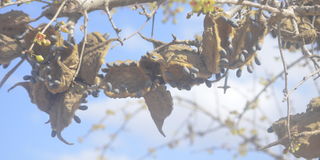It's wild berries and roots for dinner in Kilifi as drought takes toll

Moria, the wild fruit being eaten by hungry residents of Gede area in Bamba, Kilifi County.
For the last three weeks, Ms Ginorah Abajila has been sharing maize meal (ugali) with her hungry neighbours in their Mitangani village, Bamba ward, Kilifi County.
So severe is the drought that some of her other neighbours have been feeding on wild fruits and roots (moria) to survive.
“We share a packet of flour with our neighbours whenever we can. Nowadays, we rarely eat to our fill but only to calm the pangs of hunger and we cannot do so without being considerate of hungry neighbours,” she told Nation.Africa.
Some starving families have also asked the area chief to save their lives.
“The situation was bad even before the General Election. We pleaded for food from the MP and MCA, who donated some small portions of food. We are now stranded,” Ms Abajila said.
The Charo Monje water pan, which locals depended on for water, is drying up fast. But that is not the only problem.
Due to the scarcity of water, wild animals, including elephants, compete for it with locals.
“They also depended on the pan as the only available source of water. But the elephants have contaminated the water and the little that remains is not clean for human consumption. But what do we do? We have no alternative but to use it,” she said.
“We do not know where we will get help. If the government will not intervene urgently to bring food, it should be ready to hear cases where people have died due to hunger.”
The predicament of Ms Abajila and her neighbours mirrors that of many others in Kilifi’s Ganze constituency, where drought is also taking a toll on locals.
A report from Kenya Food Security Steering Group (KFSSG) and Kilifi County Steering Group (CSG) on food and nutrition for July stated that Ganze, Kaloleni, Magarini and parts of Magarini sub-counties had recorded crop failures for the last four seasons due to poor rains.
Most farmers were reluctant to plant after their maize crops dried up in April 2022, the report says.
But current crops in areas along the coastal strip, which recorded a fair amount of rainfall, were at different stages of growth as farmers continued to plant following rains in June and July.
Kilifi gets two rainfall seasons – long rains in March, April and May and short rains in October, November and December.
The long rainy season is the most reliable in the mixed farming and cash cropping/dairy livelihood areas.
It contributes about 60 per cent of the total annual agricultural production in the county.
The major crops grown in the county are maize, cowpeas, cassava and green grams. In the cash cropping/dairy farming and food-cropping areas, maize and cassava contribute 40 per cent and 20 percent of food.
Maize and cassava contribute 25 percent and 18 per cent to income in the food-cropping zone.
In the marginal mixed farming livelihood zone, maize and cassava contribute 70 per cent and 20 percent of food.
The report also stated that food prices remained high due to high demand as almost 100 per cent of households depended on the market for food supplies. Most supplies (maize, beans, omena) came from outside the county, and their prices will remain high following high fuel costs.
The trend is likely to continue until the next harvest in August.
The ongoing drought contributed to insecurity and human-wildlife and resource-based conflicts.
Resource-based conflicts were in the livestock farming zones in Magarini and Ganze sub-counties, which border Tsavo East National Park, where elephants are camping at the water sources, the report says.
Elephants are hindering communities and livestock from accessing the water points, whose levels are low because there is no rainfall to refill them.
The wild animals have blocked residents from going to farms to plant food crops. Locals fear being attacked and killed, while the animals would consume the few food crops grown.
Mrima wa Ndege location Chief Samson Chai said many families are sleeping on empty stomachs, while others depend on one meal a day.
“The hunger situation is critical now, and the community is hopeless. We expected the prices of maize flour would go down to Sh100 but it still remains at Sh200. A family of 15 people needs to have enough money to buy at least two packets of maize flour,” he said.
Mr Chai said efforts to get help from elected politicians were in vain as they kept giving excuses.
“We are trying to reach out to our leaders for help, but they keep telling us that they can’t give us support since they are not in office until the swearing-in,” he said.
He added that the area was facing a water shortage.
Mr Chai cited his location, where all water pans have dried up and residents trek over 20 kilometres to neighbouring areas to fetch water for domestic and livestock use.
He said there is a borehole in the Milore area in Mriachakwe village.
But due to high salinity, the water is not fit for human consumption and residents give it to their livestock, which is not healthy for them either.
“We don’t know where we are heading, but the hunger situation is at its worst,” he said.





